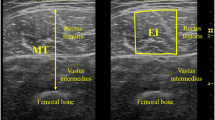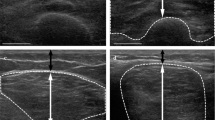Abstract
Enhanced echo intensity (EI) on an ultrasound image of skeletal muscle indicates changes in muscle quality, including increases in intramuscular fibrous and adipose tissues. However, it is not known whether muscle quality assessed from the EI of computer-aided gray-scale analysis of an ultrasound image is associated with the muscle strength or body composition of a subject. The objectives of this study were to investigate whether muscle quality assessed from EI measured using gray-scale analysis is associated with muscle strength independently of age or muscle thickness (MT), and to examine the relationship between muscle EI and body composition. Ninety-two healthy women with a mean age of 70.4 ± 5.5 years (range, 51–87 years) dwelling in Kyoto, Japan, participated in the study. The MT, subcutaneous fat thickness (FT), and EI of the quadriceps femoris on the right extremity were assessed from transverse ultrasound images. Knee extensor isometric strength was used as a measure of the quadriceps femoris muscle strength. EI was significantly correlated with quadriceps strength independently of age or MT, and stepwise regression analysis revealed that MT and EI were independently associated with quadriceps strength. Importantly, EI showed no significant correlations with FT, percentage of body fat (%BF), or body mass index (BMI), while FT, BMI, and %BF did not significantly influence muscle strength. These data suggest that muscle quantity (i.e., MT) and muscle quality assessed from EI measured using computer-aided gray-scale analysis independently contribute to muscle strength in middle-aged and elderly persons.

Similar content being viewed by others
References
Arborelius UP, Wretenberg P, Lindberg F (1992) The effects of armrests and high seat heights on lower-limb joint load and muscular activity during sitting and rising. Ergonomics 35(11):1377–1391
Arts IM, Pillen S, Schelhaas HJ, Overeem S, Zwarts MJ (2010) Normal values for quantitative muscle ultrasonography in adults. Muscle Nerve 41:32–41. doi:10.1002/mus.21458
Bargfrede M, Schwennicke A, Tumani H, Reimers CD (1999) Quantitative ultrasonograpy in focal neuropathies as compared to clinical and EMG findings. Eur J Ultrasound 10:21–29. doi:10.1016/S0929-8266(99)00040-3
Baumgartner RN, Wayne SJ, Waters DL, Janssen I, Gallagher D, Morley JE (2004) Sarcopenic obesity predicts instrumental activities of daily living disability in the elderly. Obes Res 12(12):1995–2004. doi:10.1038/oby.2004.250
Bohannon RW (1997) Comfortable and maximum walking speed of adults aged 20–79 years: reference values and determinants. Age Aging 26(1):15–19. doi:10.1093/ageing/26.1.15
Brooks SV, Faulkner JA (1994) Skeletal muscle weakness in old age: underlying mechanisms. Med Sci Sports Exerc 26(4):432–439
Frontera WR, Hughes VA, Lutz KJ, Evans WJ (1991) A cross-sectional study of muscle strength and mass in 45- to 78-year-old men and women. J Appl Physiol 71(2):644–650
Goodpaster BH, Kelley DE, Thaete FL, He J, Ross R (2000) Skeletal muscle attenuation determined by computed tomography is associated with skeletal muscle lipid content. J Appl Physiol 89(1):104–110
Goodpaster BH, Carlson CL, Visser M et al (2001) Attenuation of skeletal muscle and strength in the elderly: The Health ABC Study. J Appl Physiol 90(6):2157–2165
Hawke TJ, Garry DJ (2001) Myogenic satellite cells: physiology to molecular biology. J Appl Physiol 91(2):534–551
Heckmatt JZ, Leeman S, Dubowitz V (1982) Ultrasound imaging in the diagnosis of muscle disease. J Pediatr 101:656–660
Ishiguro N, Kanehisa H, Miyatani M, Masuo Y, Fukunaga T (2005) A comparison of three bioelectrical impedance analyses for predicting lean body mass in a population with a large difference in muscularity. Eur J Appl Physiol 94:25–35. doi:10.1007/s00421-004-1259-2
Izquierdo M, Ibañez J, Gorostiaga E et al (1999) Maximal strength and power characteristics in isometric and dynamic actions of the upper and lower extremities in middle-aged and older men. Acta Physiol Scand 167(1):57–68. doi:10.1046/j.1365-201x.1999.00590.x
Kellis S, Kellis E, Manou V, Gerodimos V (2000) Prediction of knee extensor and flexor isokinetic strength in young male soccer players. J Orthop Sports Phys Ther 30(11):693–701
Landis JR, Koch GG (1977) The measurement of observer agreement for categorical data. Biometrics 33(1):159–174
Larsson L, Li X, Frontera WR (1997) Effects of aging on shortening velocity and myosin isoform composition in single human skeletal muscle cells. Am J Physiol 272(2 Pt 1):C638–C649
Macaluso A, Nimmo MA, Foster JE, Cockburn M, McMillan NC, De Vito G (2002) Contractile muscle volume and agonist–antagonist coactivation account for differences in torque between young and older women. Muscle Nerve 25(6):858–863. doi:10.1002/mus.10113
Machida S, Booth FW (2004) Increased nuclear proteins in muscle satellite cells in aged animals as compared to young growing animals. Exp Gerontol 39(10):1521–1525. doi:10.1016/j.exger.2004.08.009
Maurits NM, Bollen AE, Windhausen A, De Jager AE, Van Der Hoeven JH (2003) Muscle ultrasound analysis: normal values and differentiation between myopathies and neuropathies. Ultrasound Med Biol 29:215–225. doi:10.1016/S0301-5629(02)00758-5
Maurits NM, Beenakker EA, van Schaik DE, Fock JM, van der Hoeven JH (2004) Muscle ultrasound in children: normal values and application to neuromuscular disorders. Ultrasound Med Biol 30:1017–1027. doi:10.1016/j.ultrasmedbio.2004.05.013
Pillen S, van Keimpema M, Nievelstein RA, Verrips A, Kruijsbergen-Raijmann W, Zwarts MJ (2006) Skeletal muscle ultrasonography: visual versus quantitative evaluation. Ultrasound Med Biol 32:1315–1321. doi:10.1016/j.ultrasmedbio.2006.05.028
Pillen S, Tak RO, Zwarts MJ et al (2009) Skeletal muscle ultrasound: correlation between fibrous tissue and echo intensity. Ultrasound Med Biol 35:443–446. doi:10.1016/j.ultrasmedbio.2008.09.016
Rantanen T, Era P, Heikkinen E (1994) Maximal isometric strength and mobility among 75-year-old men and women. Age Aging 23(2):132–137. doi:10.1093/ageing/23.2.132
Reimers K, Reimers CD, Wagner S, Paetzke I, Pongratz DE (1993) Skeletal muscle sonograpy: a correlative study of echogenicity and morphology. J Ultrasound Med 12:73–77
Reimers CD, Schlotter B, Eicke BM, Witt TN (1996) Calf enlargement in neuromuscular diseases: a quantitative ultrasound study in 350 patients and review of the literature. J Neurol Sci 143:46–56. doi:10.1016/S0022-510X(96)00037-8
Sipilä S, Suominen H (1991) Ultrasound imaging of the quadriceps muscle in elderly athletes and untrained men. Muscle Nerve 14(6):527–533. doi:10.1002/mus.880140607
Sipilä S, Suominen H (1994) Knee extension strength and walking speed in relation to quadriceps muscle composition and training in elderly women. Clin Physiol 14(4):433–442
Sipilä S, Koskinen SO, Taaffe DR et al (2004) Determinants of lower-body muscle power in early postmenopausal women. J Am Geriatr Soc 52(6):939–944. doi:10.1111/j.1532-5415.2004.52261.x
Stevens JE, Binder-Macleod S, Snyder-Mackler L (2001) Characterization of the human quadriceps muscle in active elders. Arch Phys Med Rehabil 82(7):973–978. doi:10.1053/apmr.2001.23995
Tanaka NI, Miyatani M, Masuo Y, Fukunaga T, Kanehisa H (2007) Applicability of a segmental bioelectrical impedance analysis for predicting the whole body skeletal muscle volume. J Appl Physiol 103:1688–1695. doi:10.1152/japplphysiol.00255.2007
Trip J, Pillen S, Faber CG, van Engelen BG, Zwarts MJ, Drost G (2009) Muscle ultrasound measurements and functional muscle parameters in non-dystrophic myotonias suggest structural muscle changes. Neuromuscul Disord 19:462–467. doi:10.1016/j.nmd.2009.06.369
Uezumi A, Fukada S, Yamamoto N, Takeda S, Tsuchida K (2010) Mesenchymal progenitors distinct from satellite cells contribute to ectopic fat cell formation in skeletal muscle. Nat Cell Biol 12(2):143–152. doi:10.1038/ncb2014
Visser M, Kritchevsky SB, Goodpaster BH, Newman AB, Nevitt M, Stamm E, Harris TB (2002) Leg muscle mass and composition in relation to lower extremity performance in men and women aged 70 to 79: the health, aging and body composition study. J Am Geriatr Soc 50(5):897–904. doi:10.1046/j.1532-5415.2002.50217.x
Yamada Y, Masuo Y, Yokoyama K et al (2009) Proximal electrode placement improves the estimation of body composition in obese and lean elderly during segmental bioelectrical impedance analysis. Eur J Appl Physiol 107(2):135–144. doi:10.1007/s00421-009-1106-6
Yamada Y, Schoeller DA, Nakamura E, Morimoto T, Kimura M, Oda S (2010) Extracellular water may mask actual muscle atrophy during aging. J Gerontol A Biol Sci Med Sci 65(5):510–516. doi:10.1093/gerona/glq001
Acknowledgments
The authors would like to thank Megumi Nakamura, Saori Shibuta, Shuhei Mori, Yui Takagi, and Mitsuhiro Masaki (Human Health Sciences, Graduate School of Medicine, Kyoto University) for their practical and technical assistance. The authors also thank all of the individuals who participated in the study. This study was not funded by any institutions, agencies, or companies.
Conflict of interest
The authors have no conflicts of interest to disclose.
Author information
Authors and Affiliations
Corresponding author
Additional information
Communicated by Alain Martin.
Rights and permissions
About this article
Cite this article
Fukumoto, Y., Ikezoe, T., Yamada, Y. et al. Skeletal muscle quality assessed from echo intensity is associated with muscle strength of middle-aged and elderly persons. Eur J Appl Physiol 112, 1519–1525 (2012). https://doi.org/10.1007/s00421-011-2099-5
Received:
Accepted:
Published:
Issue Date:
DOI: https://doi.org/10.1007/s00421-011-2099-5




